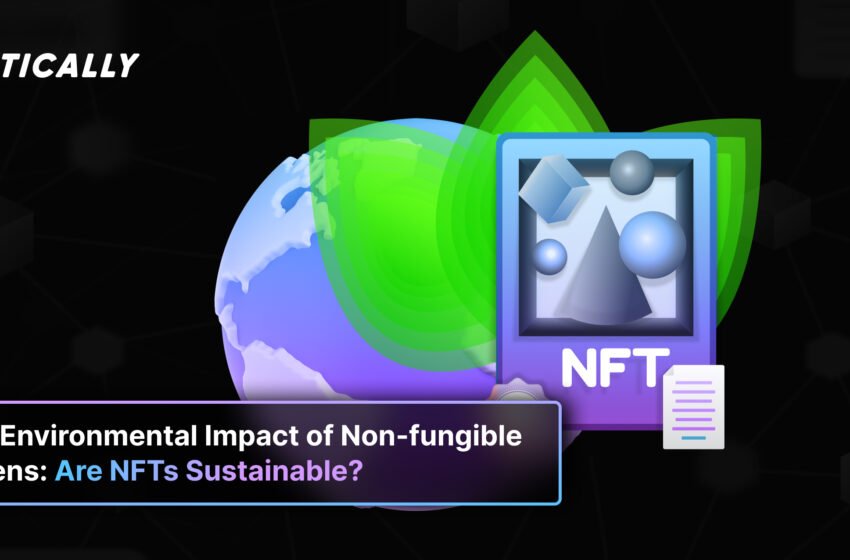Polymarket quietly changes fee model for short term crypto markets
NFTs and the Environmental Impact: Are Non-fungible Tokens Sustainable
(Originally posted on : NFTICALLY )
Technology has come a long way in terms of innovation and development over the last few decades. But its rapid advancement has had an undeniable impact on our planet’s environment. From increased emissions to increased energy consumption, technology is playing a major role in global warming and climate change. A few of the latest technologies to enter the scene are blockchain, cryptocurrencies, and non-fungible tokens.
Particularly, NFTs have been gaining popularity in recent years due to their ability to tokenize digital assets such as artwork, music, and videos. Many people look at them as a revolutionary technology that could revolutionize how we create and share digital content. But, what impact do NFTs have on the environment? In this blog post, we will explore the environmental implications of NFTs and whether we can consider them sustainable or not.
NFTs Explained
Non-fungible tokens are digital assets that are unique and not interchangeable with any other type of assets. They represent ownership of digital items such as art, videos, music, collectibles, and gaming items. You can store and trade NFTs on blockchain networks, which makes them secure and immutable. We can also use them to create new digital markets for digital assets, which allows artists and creators to monetize their work more easily.
NFTs are quickly becoming the hot new trend in the crypto world. Many people are investing in them as a way to diversify their portfolios. They offer an innovative way to own and trade digital assets, and they will likely continue to grow in popularity as more people become aware of them. If you are looking to get into these unique digital tokens, make sure to do your research and understand the risks involved before investing.
How Are NFTs Impacting the Environment?
When you would like to create, sell, or buy an NFT, the blockchain network requires energy to validate and add the transaction to a block. As digital asset trading has become increasingly popular, the networks consume more energy to support these activities. This has led some to suggest that NFTs can negatively impact the environment through their energy demands.
You can determine how much energy NFTs require by the consensus mechanism used in their blockchain network. Currently, most blockchain networks use a Proof-of-Work (PoW) consensus mechanism, which requires miners to solve complex mathematical problems to add blocks and confirm transactions. As we create, trade, or buy more non-fungible tokens, the demand for energy increases.
In addition to the energy consumed by these tokens themselves, many of them are stored on Ethereum-based networks. These networks require gas fees to complete the transactions. This further added to the environmental impact of NFTs as miners used the PoW consensus to mine Ether, which consumes more energy.
It’s important to note that non-fungible tokens are not the only type of blockchain transaction that can add to the environmental impact. Any transaction made on a PoW-based blockchain adds to the energy consumption of the network. This is why many experts argue for greater use of energy-efficient consensus methods in the future. Non-fungible tokens can contribute to a greener blockchain landscape if we use more energy-efficient consensus methods.
Energy Usage of Blockchain Networks and NFTs
The energy usage of non-fungible tokens and blockchain networks can be a controversial topic. Blockchain powers these tokens, and more broadly, NFTs and blockchain networks have been accused of consuming an excessive amount of energy. However, this is only part of the story because NFT transactions do not necessarily use any additional energy beyond what is already being used to power the blockchain network. They are contained in a single block, so all of the energy that goes into mining each block applies to digital token transactions as well.
Therefore, non-fungible tokens do not necessarily create an extra burden on the environment by consuming additional energy. But, the energy usage of these tokens may vary depending on the blockchain and its consensus mechanism. The underlying technology of digital assets, such as Ethereum or EOS, does consume a significant amount of energy which is worth considering. Additionally, you need to compensate miners for their work of validating transactions by incentivizing them.
Thankfully, researchers at Protocol Labs have been looking into the impact NFTs and other blockchain networks have on the environment. Their research has shown that NFTs do not significantly increase the energy usage of various blockchain networks. In fact, NFTs may actually be more energy efficient than traditional methods of creating digital art and other collectibles.
Finally, these unique digital tokens are still a relatively new technology so there is no definitive answer to their environmental impact at this time. However, it is important to be aware of the energy consumption as well as the potential benefits of these tokens. These benefits may include reducing physical waste and providing a more efficient marketplace for art and other digital assets. As the technology continues to evolve, the best we can do is to be aware and strive for greater energy efficiency in NFTs and blockchain networks.
Is Proof-of-Stake Really the Solution?
It certainly seems like Proof-of-Stake (PoS) is a part of the solution to reducing NFTs’ environmental consumption. In fact, research has shown that PoS can reduce energy consumption by orders of magnitude compared to PoW. This means their transactions could be more efficient and have a much lower carbon footprint.
However, PoS does have certain limitations. It requires a high level of trust and consensus from users to ensure that all validators are doing their jobs properly. As such, we need more research and experimentation before digital tokens are ready to switch fully over to Proof-of-Stake.
So, while non-fungible tokens may have a certain environmental cost associated with them, it doesn’t have to be that way. Through the use of advanced blockchain technologies like Proof-of-Stake, digital tokens can become much more energy-efficient and sustainable. That’s a win-win for investors, blockchain developers, and the environment.
The Merge: A Significant Reduction in Energy Consumption
The Merge event of Ethereum was a long-awaited process that promised to bring significant changes to the blockchain world. As a result of it, Ethereum has achieved a significant reduction in energy consumption of up to 99.95%. To understand how it has brought about such an impressive reduction in energy consumption, it’s important to look at the underlying technology.
At its core, Ethereum was using Proof-of-Work (PoW) consensus protocol. This system is less efficient than other alternatives such as Proof-of-Stake (PoS), which requires far fewer resources to operate. After The Merge on September 15, 2022, Ethereum switched from PoW to PoS consensus, which has resulted in a much more energy-efficient network. In addition, Ethereum also implemented several measures to improve scalability and reduce gas fees. This further reduces the amount of energy required to run the network.
The Merge was a significant milestone for blockchain technology and NFTs, as it shows that blockchain can evolve in positive ways. With more developers beginning to recognize the potential of blockchain, the environmental impact is only going to become more important.
The NFT sector is still relatively young, but it has already made great strides in reducing its environmental impact. With ongoing improvements and innovations, digital tokens can continue to make progress toward becoming more sustainable. As the blockchain industry continues to evolve, non-fungible tokens will be an integral part of its success.
Can You Buy Energy-Efficient NFTs?
Yes. Non-fungible tokens can be incredibly energy-efficient when you buy from the right places. They are digital collectibles that exist on a blockchain network and require energy for minting and transaction validation. By choosing blockchains with more efficient consensus mechanisms like Liquid Proof-of-Stake (LPoS) and Proof-of-History (PoH), digital assets can use significantly less energy to operate.
For example, Solana is a combination of PoS and PoH consensus mechanisms. It supports NFT marketplaces like Rarible, Magic Eden, and Solanart. These are the perfect places to purchase unique digital tokens that have a low environmental impact. Tezos is another greener alternative as it uses the LPoS consensus mechanism and consumes around 2 million times less energy than Ethereum before the Merge.
We mention Ethereum several times throughout this article because it is the most popular blockchain with several NFT, GameFi, and DeFi projects built on it. We can also consider Ethereum to buy digital tokens as its energy consumption reduced significantly after The Merge. Algorand and Cardano are a few of the other options. So if you want to support NFT artists while contributing to a greener future, buying these assets from these marketplaces is a great way to do it.
Conclusion
Through the use of advanced blockchain technologies like Proof-of-Stake, non-fungible tokens can become much more energy-efficient and sustainable. We’ve discussed how Ethereum has achieved a significant reduction in energy consumption through its Merge event. As well as other blockchains that offer greener alternatives for NFT purchases such as Solana, Tezos, Algorand, and Cardano. Whether you are an investor or a collector looking to support artists while contributing to a greener future, buying tokens from these marketplaces is one way you can do your part now.
NFTICALLY is an innovative platform that helps you launch your own collections without any technical knowledge. So, explore the platform today to know all the benefits NFTs can offer you!








 Bitcoin
Bitcoin  Ethereum
Ethereum  Tether
Tether  XRP
XRP  USDC
USDC  Lido Staked Ether
Lido Staked Ether  TRON
TRON  Dogecoin
Dogecoin  Cardano
Cardano  Figure Heloc
Figure Heloc  Wrapped stETH
Wrapped stETH  Bitcoin Cash
Bitcoin Cash  WhiteBIT Coin
WhiteBIT Coin  Wrapped Bitcoin
Wrapped Bitcoin  Wrapped eETH
Wrapped eETH  Chainlink
Chainlink  USDS
USDS  Binance Bridged USDT (BNB Smart Chain)
Binance Bridged USDT (BNB Smart Chain)  Zcash
Zcash  WETH
WETH  Monero
Monero  LEO Token
LEO Token  Stellar
Stellar  Sui
Sui  Coinbase Wrapped BTC
Coinbase Wrapped BTC  Hyperliquid
Hyperliquid  Litecoin
Litecoin  Avalanche
Avalanche  Ethena USDe
Ethena USDe  Hedera
Hedera  Shiba Inu
Shiba Inu  Canton
Canton  World Liberty Financial
World Liberty Financial  Toncoin
Toncoin  sUSDS
sUSDS  USDT0
USDT0  Cronos
Cronos  Dai
Dai  Uniswap
Uniswap  Polkadot
Polkadot  Mantle
Mantle  PayPal USD
PayPal USD  Ethena Staked USDe
Ethena Staked USDe  USD1
USD1  Rain
Rain  Pepe
Pepe  Bittensor
Bittensor  MemeCore
MemeCore  Aave
Aave  Bitget Token
Bitget Token  OKB
OKB  NEAR Protocol
NEAR Protocol  Tether Gold
Tether Gold  Falcon USD
Falcon USD  Ethereum Classic
Ethereum Classic  Ethena
Ethena  Jito Staked SOL
Jito Staked SOL  Binance-Peg WETH
Binance-Peg WETH  Internet Computer
Internet Computer  Aster
Aster  Pi Network
Pi Network  Worldcoin
Worldcoin  Wrapped SOL
Wrapped SOL  BlackRock USD Institutional Digital Liquidity Fund
BlackRock USD Institutional Digital Liquidity Fund  PAX Gold
PAX Gold  Jupiter Perpetuals Liquidity Provider Token
Jupiter Perpetuals Liquidity Provider Token  HTX DAO
HTX DAO  KuCoin
KuCoin  Circle USYC
Circle USYC  Global Dollar
Global Dollar  Binance Staked SOL
Binance Staked SOL  Aptos
Aptos  Pump.fun
Pump.fun  Ondo
Ondo  Sky
Sky  syrupUSDC
syrupUSDC  POL (ex-MATIC)
POL (ex-MATIC)  Rocket Pool ETH
Rocket Pool ETH  Ripple USD
Ripple USD  Wrapped BNB
Wrapped BNB  BFUSD
BFUSD  Midnight
Midnight  Arbitrum
Arbitrum  Binance Bridged USDC (BNB Smart Chain)
Binance Bridged USDC (BNB Smart Chain)  Algorand
Algorand  Render
Render  Gate
Gate  Cosmos Hub
Cosmos Hub  Filecoin
Filecoin  Quant
Quant  VeChain
VeChain  Official Trump
Official Trump  Bonk
Bonk  Function FBTC
Function FBTC